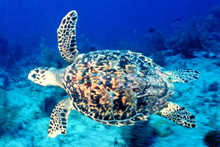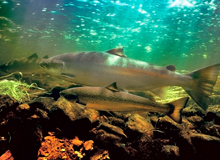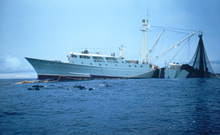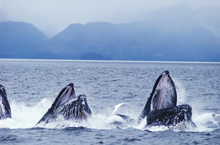Evolving to Protect Marine Mammals and Endangered Species
NOAA works to conserve and protect marine mammals, endangered species, and their habitats. Activities range from the development of policies and regulations needed to implement the Marine Mammal Protection Act and the Endangered Species Act to scientific research needed to understand these valuable creatures to outreach and education needed to promote conservation and respect for the animals and the marine environment.
Imagine a time when half a million dolphins died accidentally each year as unintended bycatch from one fishery. Or imagine large whales being commercially hunted to the brink of extinction.

This endangered hawksbill turtle is one of many species NOAA is working to protect through stringent regulations and modern conservation gear. Click image for larger view.
These catastrophic events are not depictions from a science fiction novel, but were reality only four decades ago. As a result of these and other grim scenarios, attitudes towards marine mammals have shifted over the past few decades and legislation is now in place to protect these valued marine treasures.
This article looks at changing attitudes towards marine mammals, which led to the passage of important legislation designed to protect them. Two specific examples are used to show how marine mammal protection has changed in the last few decades.
Evolving Attitudes and Policies
For centuries, U.S. attitudes toward animals and their natural environments have been evolving. Not that long ago, animals were thought of as primarily resources for human use and consumption. Today, animals are recognized to have an intrinsic right to life, bringing a value to the world that is more than purely economic.

Early efforts at seal harvest regulations came from the 1897 International Seal Conference, which included famed American scientist, David Starr Jordan (standing, fourth from left) and former Secretary of State John W. Foster (seated, center). Click image for larger view.
However, it was not until the 1960s that this attitude toward animals, including marine mammals, changed from viewing animals as resources and commodities to developing policies dedicated to their protection.
The Marine Mammal Protection Act
The Marine Mammal Protection Act of 1972 (MMPA) was enacted when it became clear that state laws provided inconsistent and ineffectual marine mammal protection. The MMPA was born in the face of specific, high-profile, ecological disasters: dolphins drowning in purse seine nets used to catch yellowfin tuna in the eastern tropical Pacific Ocean; newborn harp and hooded seals being slaughtered for fur trade; and great whale species being at the brink of extinction due to unrelenting commercial hunting.

Pribiloff Islands fur seals, already on the decline, are shown in a late 19th century drawing by Henry W. Elliot. The Fisheries and Fishery Industries of the United States, 1887. Click image for larger view.
Concerned about the fate of individual species, marine ecosystem protection, marine mammal research, and international cooperation, the authors of the MMPA brought all of these threads together in one law.
Under the MMPA, NOAA is responsible for the conservation of all cetaceans (whales, dolphins, and porpoises) and all seals and sea lions. NOAA also works with various constituents and industries to ensure that human activities do not impact the sustainable nature of healthy marine mammal populations and that programs promote the recovery of depleted populations.
The Endangered Species Act
The Endangered Species Act of 1973 (ESA) specifically protects organisms that are threatened or endangered. ESA supports the Marine Mammal Protection Act, with particular attention to the alarming decline in great whales.

Several stocks of West coast Coho salmon are among those listed under the Endangered Species Act. Click image for larger view.
There are currently 1,879 listings (endangered and threatened) under the ESA, with 1,310 of those species found in the United States or its waters. NOAA's National Marine Fisheries Service and the U.S. Fish and Wildlife Service (FWS) share responsibility for implementing the ESA. Generally, FWS manages terrestrial and freshwater species, while the National Marine Fisheries Service manages marine species, including anadromous salmon (ocean species that return to rivers to spawn). The National Marine Fisheries Service is responsible for 64 listed species.
Progress and Change
Tremendous progress has been made over the past few decades toward the conservation and protection of marine mammals and endangered species. The need to protect these creatures has inspired technological advancements in harvesting technology, such as Turtle Excluder Devices, which allow endangered and threatened sea turtles to escape from fishing nets. Regulations have helped promote increased public awareness of the range and subtlety of human and animal ecological interactions. Modern science is only now beginning to uncover the cause and effects of the deeper, more persistent concerns in human and animal interactions.
Case Studies in the Transformation of Marine Mammal Protection
Below are specific examples of instances in which NOAA’s actions are helping to protect two of the most recognizable marine mammals in the ocean: dolphins and whales.
“Dolphin-Safe” Fishing Practices
Yellowfin tuna associate closely with dolphins in the eastern tropical Pacific Ocean (ETP). In the late 1950s, the U.S. tuna fleet began to exploit this bond by encircling dolphins with purse seine nets to catch the tuna swimming below. Numerous dolphins became trapped in the nets and drowned before they could be released. During the early years of this fishery, hundreds of thousands of dolphins perished each year. By 1971, an estimated at five million dolphins had died due to the tuna fishery and purse seine operations.

“Backing down” the nets on a modern tuna clipper, a benchmark of marine mammal conservation, permitted trapped dolphins to escape.
When the U.S. Marine Mammal Protection Act was passed in 1972, it included provisions for reducing bycatch to "insignificant levels approaching zero" by establishing a moratorium on the take of marine mammals. During this time, the tuna industry was expected to develop improved fishing methods to solve the bycatch problem. Pursuant to the MMPA, NOAA initiated scientific studies, placed observers on fishing boats, inspected fishing gear, and reviewed boat captains with high dolphin mortality rates. NOAA helped develop modification of fishing gear and procedures to reduce dolphin mortality, and ultimately published regulations for the U.S. fishery. By the end of the 1970s, the kill had declined from about 500,000 to about 20,000 dolphins per year.
As the U.S. tuna fleet decreased in size due to regulatory controls, the fleets of Mexico, Venezuela, Ecuador, and other Latin American countries increased, and dolphin mortality began to grow again, reaching approximately 133,000 by 1986. Accordingly, NOAA’s actions to monitor and reduce the dolphin bycatch became international.
In 1990, Congress passed the Dolphin Protection Consumer Information Act (DCPIA) which established the U.S. dolphin-safe labeling standard for tuna harvested in the ETP. Under the DCPIA, tuna can be labeled “dolphin-safe” only if the tuna were harvested on a trip in which no purse seine nets were used to encircle dolphins, and no dolphins were killed or seriously injured during the sets in which tuna were caught. These market measures, along with the growing cultural awareness in the U.S. consumer market of the importance of healthy ocean ecosystems, created a potent force for change.
Partnering with the U.S. Department of State, NOAA helped negotiate a series of international agreements. The Inter-American Tropical Tuna Commission began a dolphin conservation program in 1979, modeled after the U.S. effort. Starting in 1993, the ETP fishing countries voluntarily agreed to increased observer coverage, skipper review panels, and a schedule of decreasing dolphin quotas on an individual boat basis (the La Jolla Agreement). The Declaration of Panama of 1995 carried these ideas further, proposing observers on every boat over 400 tons and strict “per-stock” dolphin mortality limits. These features became part of the Agreement on the International Dolphin Conservation Program (AIDCP), a legally binding treaty among the major fishing and coastal countries that went into effect in 1999.
In 2005, observed dolphin mortality in the fishery had decreased to 1,200 animals and the Food and Agriculture Organization of the United Nations awarded the AIDCP with the Margarita Lizárraga medal. The medal was awarded in recognition of the program's comprehensive, sustainable, and catalytic initiatives in support of the Code of Conduct for Responsible Fisheries, outstanding work in conserving the resources of the eastern Pacific tuna fisheries, and, in particular, its groundbreaking measures to protect dolphins.
Protecting the North Atlantic Right Whale
The persistent exploitation of the North Atlantic right whale from the 11th century to the mid-1900s made it one of the world’s most critically endangered mammals. Today, there are only about 300 North Atlantic right whales.
Although commercial whaling for right whales was banned by international agreement in the 1930s, the species has shown no sign of population growth since that time. Scientific research shows that growth in human, marine-related activities is responsible for this lack of recovery. For example, nearly half of all documented North Atlantic right whale deaths since 1990 were due to ship strikes. Also, growth in offshore fisheries has led to increased Right Whale mortality from entanglements in nets and other fishing gear.
NOAA's National Marine Fisheries Service has proposed new regulations to reduce the likelihood of ship collisions with right whales in coastal shipping lanes. The proposed rule would implement speed restrictions of 10 knots or less for vessels 65 feet or greater in length. The restrictions would be in place for certain times and areas along the U.S. Atlantic seaboard that correspond to right whale occurrence.
New regulations would allow temporary “dynamic management” areas in times and/or areas where other seasonal management measures are not in effect and where whales may occur unexpectedly. In locations where dynamic management areas are established, mariners would have the option to cross through the area at a speed no greater than 10 knots or route around the area.

NOAA’s goal of restoring dangerously low stocks of whales has resulted in gains for most species and a thriving boon to coastal community’s whale-watching industry. Click image for larger view.
To further protect right whales, NOAA is working with partners in Boston, Massachusetts to reconfigure the travel patterns of ships coming in and out of Boston ports. Boston is a region of particularly high shipping-whale interactions, and NOAA believes that this effort will result in an estimated 58 percent reduction in the risk of ship strikes to right whales. Reducing this risk could play a significant role in helping the species recover.
Conclusion
The Marine Mammal Protection Act and Endangered Species Act were visionary for their time. While tremendous progress has been made since the laws were enacted in the early 1970s, much work remains to be done. Although more is known now about marine mammals and their habitat, the development of solutions to the threats remains as complex and convoluted as when the law was enacted.
NOAA must balance the protection of these species and their populations with the economic needs of the nation. A healthy economy depends on a healthy environment. Marine mammals are an important part of the ecosystems NOAA works to protect.
